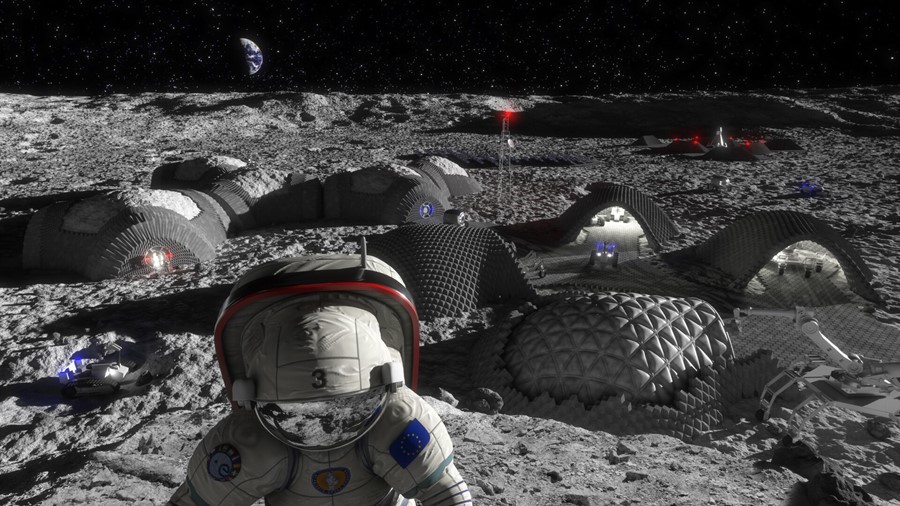NASA, the European Space Agency, and more are pouring resources into building humanity’s first moonbase – but what’s the point?
In 1969, the Apollo 11 mission saw the first humans step foot on the moon, marking the end of the space race and the beginning of a new era of exploration. Six more trips followed, five of them ending in successful spacewalks. But then, in 1972, we abruptly stopped visiting. Numerous space-based milestones have been reached since then – from the assembly of the International Space Station, to the ongoing exploration of Mars – but nothing has captured the public imagination quite like moonwalking.
So... why did we stop? Maybe unsurprisingly, the main reason was money. The cost of sending astronauts to the moon was (and still is) quite literally astronomical. Plus, since the space race was already won, there wasn’t much political incentive to fund efforts over the last 50 years. Now, though, that’s all set to change.
Last week, NASA unveiled a next-generation spacesuit for a new mission to the lunar surface, scheduled to take place before the end of the decade. The buildup is already underway. Artemis 1, a mission that saw the space agency’s newest technology fly around the moon and back, was successfully completed in December. Artemis 2 is set to do the same thing as early as next year, with a crew of four astronauts. If all goes well, the Artemis 3 mission will see space boots on the lunar surface before the end of the 2020s. For the first time, human beings will visit the moon’s south pole. The astronauts will also include the first-ever female moonwalker, with NASA promising that the first person of colour on the moon will be sent up in following Artemis missions.
Artemis isn’t just a mission to diversify the moon, though (wait until the moon landing conspiracists found out that spaceflight’s gone woke). As technology improves and spaceflight becomes increasingly viable, NASA is finding new incentives to visit the moon in person, and it isn’t alone. Last month, China unveiled a new lunar lander and announced its hopes to put the first Chinese astronauts on the surface by 2030. This week, the UK backed Rolls-Royce in the development of a nuclear power source for a potential future moon base. The European Space Agency (or ESA) is pouring resources into helping NASA get back to the moon, developing modules for its crew transportation system as well as critical parts of its Lunar Gateway. The ESA also has its own lunar lander under development, which is expected to launch in the early 2030s.
Everyone, it seems, wants a piece of the cheese. Why now? Well, for a long time the main focus of the space community was the International Space Station, says ESA’s Bernhard Hufenbach. However, when the ISS was deemed a success in the 2000s, they began to look beyond it. “It was simply a question of what’s next for human spaceflight.” This led to the publication of the Global Exploration Strategy in 2007, which lays out a roadmap for what comes next: “The moon, and then Mars, as a long-term goal.”
Today, establishing a fixed presence on the moon is considered “the next step in human spaceflight”, Hufenbach explains. “But it’s always seen as a step to prepare for the Mars mission. The Mars mission is still the holy grail of human spaceflight because it’s scientifically interesting and would be the first other planet we visit. And there’s consensus among the expert community that [we] need to learn a lot to go to Mars, and the moon is a good stepping stone.”

If the moon is just a “stepping stone” for Mars, though, then why are we so obsessed with setting up a permanent base there? Why are NASA and US officials discussing laws for future settlements on the moon? Why is ESA trying to give the moon its own time zone, for “autonomous” astronauts to measure their daily lives on the lunar surface?
In part, the desire to establish a permanent, self-sustaining presence is politically motivated, Hufenbach admits, likening the current competition to the race between Russia and the US in the Apollo era (although now many more commercial players, like SpaceX or Axiom, are in the mix). Basically, superpowers are looking for new ways to show off their industrial and technological prowess. Plus, there’s an economic incentive: “You extend the economy into space... there could very well be an economic impact, also because of the technology and innovation you create,” he notes. “Not being part of it means not being part of the elite.”
On a less cynical note, there’s also the question of the scientific knowledge to be gained from any pioneering space mission. “I think you learn a lot about the universe, history, the future, life in the universe,” Hufenbach adds. “There’s an unquestionable richness of scientific knowledge you can gain.” Ideally, the scientific knowledge gained from populating the “very aggressive environment” of the moon could help us in our efforts to colonise other planets – where longer stays would be necessary – and, in the end, become a multi-planetary species.
“[On the moon] there is radiation, there is abrasive dust,” says Hufenbach. “It’s a question of astronaut health. And it’s a question of how machines survive, and how we create sufficient power to survive the lunar night. Can we produce locally what we need for life support, for energy? Testing the limits of how far we can go and how long we can stay.”

If Hufenbach isn’t making moon travel sound very appealing, that’s because it’s not – at least to begin with. “It’s more like a research station in Antarctica for doing science, maybe some tourism,” he says. “The classical scenario is that we build something like a space station on the moon. That means we build metallic modules, bring them to the moon, and then protect them against radiation.” That’s not to say that there couldn’t be more innovative accommodation in the future, though, which could even involve tunnelling down inside lunar caves.
As moon travel becomes more accessible and commercial uses such as tourism grow, that could also spark a wave of more glamorous settlements on the moon, but Hufenbach suggests a cosy weekend getaway isn’t something to consider in the near future. “In the early days, it’s looking more like going camping – very simple, not very comfortable, small volumes,” he says. “The whole question of design becomes more relevant if we decide to stay on the moon for longer time periods, and then we need much more than a habitat. We need power, we need local fuel production. That really becomes a small settlement.”
Admittedly, there’s a very valid argument to be made that all of this is completely pointless, even if it is preparing us for a future on Mars. After all, what’s the point in jetting off to another planet when we can’t even look after our own? Echoing common arguments against the wastefulness of space exploration, Hufenbach responds that investment isn’t simply blasted off beyond our atmosphere – on Earth, it stimulates the economy and creates new jobs. (Although so would investment in green energy and ecological repair, so that might not sound too convincing.) On the other hand, he also says that spaceflight inventions can be applied across various other sectors. For example, learning to create a self-sustaining, livable environment with little to no local resources could lead to a radical rethinking of how we produce fuel and food on Earth.
Teams across all 50 U.S. states and 10 European nations helped make Orion's trip around the Moon on Artemis I a success!
— Orion Spacecraft (@NASA_Orion) March 27, 2023
Read more about them: https://t.co/5c15HydWk5pic.twitter.com/LiOMv9ZrbF
Obviously, there are many such technical advancements that need to be made before we actually set up a functioning moon base – not to mention all of the rules and regulations, such as where you can land your landers, and what countries will be allowed to “settle” a slice of lunar surface. (At the moment, Hufenbach says it’s essentially “first come, first served”.) But scientific knowledge increases exponentially, and developments in AI and biotech are only set to speed up humanity’s quest to become multi-planetary.
“I think for babies born now it will be common to buy tickets to visit a space station, certainly in a low Earth orbit, in their lifetime,” Hufenbach predicts. “I also think lunar tourism will become a reality in their lifetime.” Within the next 50 years, he also suspects that it will become normal to consider trips to the moon and Mars, just as we might take a plane to anywhere on Earth.
This kind of space travel doesn’t just have radical implications for science, but for the whole of human consciousness, on the same scale as our realisation that the Earth isn’t flat, or that our planet isn’t at the centre of the solar system. For the first time, we could end up living in a society where a significant portion of people have seen the “Blue Marble” from an outside perspective – not just in famous images, but with their own eyes. Could this change our perspective on the planet itself? As Apollo 8 astronaut Bill Anders said, having completed the first journey beyond Earth’s orbit to circle the moon: “We came all this way to explore the moon, and the most important thing is that we discovered the Earth.”
Join Dazed Club and be part of our world! You get exclusive access to events, parties, festivals and our editors, as well as a free subscription to Dazed for a year. Join for £5/month today.




